| Author |
Message |
    
Forummaster
Moderator
Username: Forummaster
Post Number: 550
Registered: 11-2001

| | Posted on Thursday, April 07, 2011 - 10:02 pm: | 


|
Big Coil Antennas EXPOSED!
by Tech833
Full article now online- http://www.copperelectronics.com/articles/big_coil_antennas_exposed.html
For a long time, the Copper Forum Master and others, including myself, have wondered if there is really a performance advantage to all the giant coiled antennas parading up and down the highways. What are these monstrous hunks of metal, and where did they come from? Why do CBers seem to love them so much? Do they really work better than the antennas we are familiar with and grew up with? Inquiring minds need to know.
As with all good investigations, we need to start at the beginning. This story begins years ago with an antenna company known as Antenna Specialists. About the time CB radio was created, there were hams using the 11m band as it was part of the 10m band for sake of simplicity. There weren’t many commercially made amateur antennas, so many hams adapted commercial band antennas for their use. Most people used the full-length 9-foot steel whips, usually with a bumper or side body mount.
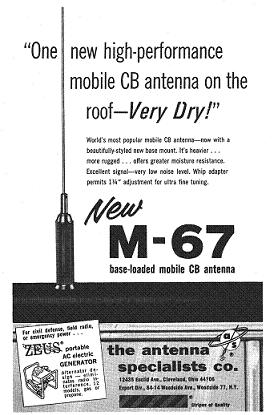
When the CB craze began to really take off in the early 1960’s, Antenna Specialists saw the coming demand and began to produce antennas specifically for the CB band and market them to this new, growing segment of the population. CBers wanted an antenna they could mount in the center of a vehicle roof for good omni coverage.
The model M67, shown here in a 1964 S9 magazine ad, was a modified version of their already in production 30-50 MHz. commercial base loaded roof mount antenna which was the benchmark in physically shortened antennas in their lineup. Several mounts and configurations were available, all centered around the basic design adapted from their commercial lowband antennas of the same look and design. Other antenna makers produced nearly exact copies of the M67 with small variations on the same design.
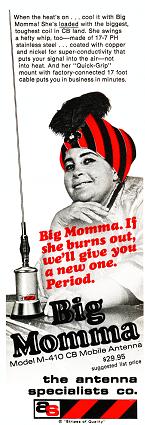
CBers are an inquisitive bunch, and it wasn’t long before CBers began using linear amplifiers to boost their output power, and were causing M67s and their clones to fail. In the early 1970s, right in the middle of the huge CB hobby boom, Antenna Specialists came out with what could be considered the first ‘big coil’ antenna, the M-410.
The M-410, affectionately known as the “Big Momma”, is shown here in a 1972 S9 magazine ad complete with the real-life ‘Big Momma’ herself. The Big Momma antenna sported a larger diameter coil form, wound with large diameter nickel and copper plated solid wire, and was incredibly successful. The Big Momma was also a little longer than the M67, and almost everyone noticed a performance improvement. And, Big Momma could take all the power mobile amps of the day could dish out. Just a couple years later, Antenna Specialists introduced the ‘trucker’ version of their successful Big Momma, with a center loaded big coil antenna that everyone soon came to know as the “beer can”.
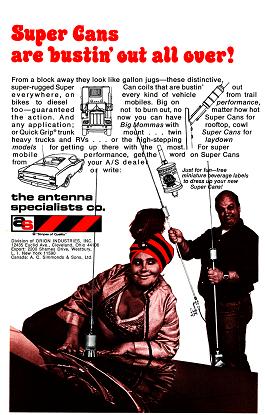
This ad from a 1974 CB radio magazine shows why. Since this antenna was the first of its kind, most people had never seen anything like them, and most thought them to be too ugly to put on their rigs. Antenna Specialists began including stickers that looked like various popular beer labels to wrap around the coil housings as a joke. It made the antennas look like an empty beer can skewered on a metal sword. It was silly, and it worked- the beer cans became wildly popular not just on big rigs, but on the family car too. The trend continued, as other antenna makers built variations of the Big Momma and Beer Can giant coil antennas in various shapes and sizes (any of you old timers remember the Sears “Road Talkers”?). Almost all still had a coil wound on a form, hidden away inside a colored plastic or fiberglass coil cover.
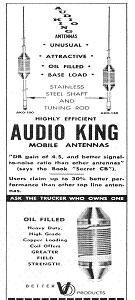
In 1981, the innovative Van Ordt antenna company took a step outside the box and introduced the “Audio King” antenna. For the first time, we could actually see the coil inside a clear plastic cover. And, as if it wasn’t different enough to use clear plastic for the coil cover, Van Ordt also filled the coil enclosure with oil, which was intended to help keep the coil wire itself cool when running higher than legal power. You would be proud to own a set of Audio Kings, and your friends would be talking about them on the radio because at the time, these antennas left a lasting visual impression with their unusual wow factor.
This ad from a 1981 CB Radio magazine touts the “Audio King” oil coil with claims of performance improvement and lower receiver noise. The Audio King was much more expensive than the fiberglass antennas, but still sold well.
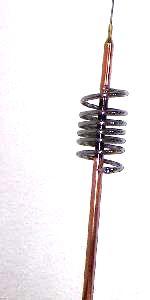
Roughly a year later, a long-haul truck driver named Jerry Laughlin was fuming at the loss of yet another CB antenna on his truck, as it succumbed to the effects of the continuous pounding vibration of his mirror mounts. In a semi truck, you can’t just stop and buy an antenna every time one breaks, you have to get your load to its destination, and now you have to do it without your CB radio to help you. On his next day off, Jerry set out to build an antenna that would handle higher than legal power, and would stand up to tremendous abuse. He built the very first open “giant coil” antenna out of materials on hand. Others that saw his antenna wanted one too, and the Whiskey Still antenna company was born. The name comes from the appearance of the tubing coil and its similarity to the copper condenser coil on a still used to produce moonshine.
Other homegrown antenna experimenters produced copies and antennas somewhat similar to the Whiskey Still, sometimes with minor design changes. But no mainstream antenna maker ever stepped up to the plate to mass-produce any.
All the ‘giant coil’ antennas produced thus far were built in someone’s garage. Several claim to have pioneered the ‘giant coil’ antenna, but it is clear, after an interview with Jerry, the Whiskey Still was indeed the first. Jerry says, “I sold Whiskey Stills to a few truck stops, and a CB shop picked them up too. They were way different and everybody wanted one. I just wanted antennas that wouldn’t break.”
Whiskey Still Antenna Company couldn’t produce antennas at the rate Antenna Specialists or any of the other large companies could, yet this product held its own with large orders being placed by truck stops and a few CB shops. The eager buyers were Whiskey Still’s only advertising. Jerry says, “I didn’t know anything about antennas when I started building the Whiskey Still. I just knew this looked right and they worked. Truck drivers spread the word.”
Fast forward a few years to 1989 when Billy Ward took the Whiskey Still idea to the next level, using sound antenna design practices, and created the Viper. The final Viper production design was settled upon in 1992 and Billy went on to produce over 18,000 Viper antennas. The Viper was the first ‘commercially available’ giant coil antenna, and well received by the CB population. In an interview, Billy said, “The Viper Antenna Built by ‘Antennas By MasterCraft’, which was me and my wife, were designed to be the best antenna on the market.” Billy continues, “I utilized every technique that I could to make it as good as it could be.”
The design of the Viper signaled a great deal of thinking and research was finally going into CB-only products. Billy told this interviewer, “First of all, the power rating was just a guess at 30,000 watts. I actually had the opportunity to test it with 20,000 watts swing to 45,000 on audio peaks. The very large size of the Viper caused it to be very wide banded which is of course normally a trade-off for gain. Since antennas of that size have almost no gain at all anyway, I sized it to cover as many channels as possible without it being too heavy to use on a mirror mount on a big truck.”
Billy Ward went on to produce many other items for the CB radio consumer market.
Lately we have seen a lot of giant coil antennas on the market, widely available through online sellers and even at truck stops. The most common is the Workman SP-3000, which can literally be found everywhere, including eBay.
So, why are the giant coil antennas so popular? It has become widely adopted by a lot of CBers that the giant coil antennas work better than other types of antennas, but for reasons ‘unknown’. Do they have huge gain over a fiberglass or other mobile antenna? Or, is it just more CB radio folklore? Your CB radio 'myth-buster' is here to find out.
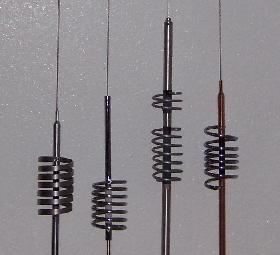
We have to start with what makes one antenna work better than another on your mobile. Almost everyone agrees that the 9-foot whip is the highest gain antenna that you can easily use on a moving vehicle. The 9-foot whip, in theory, has about 2.1 dB less gain than a 1/2 wave dipole often used for reference. Many factors, including the antenna ground and the earth ground make this a near impossibility to calculate with great certainty, but for the sake of this investigation we can use that number as a base.
Since these are mobile antennas we are comparing, we are now assuming that a 9-foot whip is going to be our standard to compare others to. And as such, we have to assume that any antenna shorter than the 9-foot whip would have less gain compared to it, right? Well, some giant coil antenna sales pitches claim they have gain OVER a 9-foot whip, how is that possible?
Admittedly, if you spin an antenna on a test range and plot its E-field radiation pattern, it is possible, even on low gain antennas, to have a small lobe or part of the radiated pattern shoot off in some direction with greater signal density and throw the gain figures off, if you measure gain in that particular direction only. Mobiles aren’t ‘perfect ground’ as used by software antenna modeling programs, and they are often unpredictable anyway.
Clearly, using simple gain figures isn’t going to be fair in this case. Bandwidth, RF resistance, elevation radiation angle, and lots of other factors inherent to mobile installations obsolete the use of simple gain figures to determine which mobile antenna will work better than another.
This time, it is complicated; we need to use something repeatable and fair to find out if giant coil antennas really do work better or not. This overall figure would be best described as the antenna’s “efficiency” compared to the 9-foot whip. In order to do this, we have to completely measure all aspects and radiation characteristics of a 9-foot whip so it can become our calibration mark.
This investigation travels to the antenna test range. A 9-foot whip is mounted to several different vehicles to see if that makes much difference. Then, to metal objects that are of appropriate size to mount on the turntable, including a car hood, a truck lumber rack, a truck mirror mount on metal plate (to simulate mounting on a big-rig), and several measurements made. It is found that the numbers from the lumber rack mount and the truck mirror mount are nearly identical in every way. Mounting the antenna to a large truck hood is close to an ideal ground plane as the numbers nearly match those the computer spits out when modeling a 9-foot whip. Since most trucker antennas are used on semi trucks, it is decided to perform this investigation with numbers derived using the antennas mounted on the lumber rack to simulate the mounting on a semi truck. The lumber rack is small enough to mount to the turntable in 3 dimensions, so that E-field and H-field measurements can easily be made. It would be impossible to do this with a real-life semi truck! Good thing the lumber rack works the same.
With all the measurements using our 1/4 wave whip in hand, a formula is created that establishes our 9-foot antenna as the benchmark, and it is entered into the computer and normalized to 100%. Of course a 9-foot whip is not actually 100% efficient, we are only using this as the calibration point, so 100% is a standardized number, not an actual one. In theory, a 1/2 wave dipole would be 171% efficient compared to our 9-foot whip, and a short fiberglass antenna comes up to just 64% efficient. That is pretty close to what we would see in dB/m signal difference in the real world. This should work!
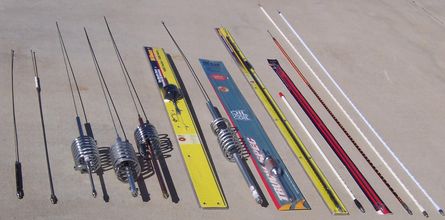
So, now it comes time to decide which antennas we should compare against our 9-foot 1/4 wave whip. I purchased some antennas including a Workman SP-3000 and a K40 fiberglass from Copper about the same time I put the call (and emails) out to antenna makers and suppliers. Whiskey Still antennas delivered 2 complete antennas and parts. Copper Electronics provided several other antennas including various fiberglass types, a Wilson 5000 Trucker, a Truck-Spec Oil Coil (similar to the “Audio King”), and the brand new K40 BCMAX (almost exact duplicate of the Viper). Mike Murray of Monkey Made Antennas sent an MM9, and “Bullet Bob’s CB” handed me two of the all-copper giant coil antennas.
None of the other antenna makers seemed interested, or even cared to reply to my repeated inquiries. I really wanted to include a Predator 10K antenna in this experiment, and was disappointed that they did not have the courtesy to respond. But, a fellow ham radio guy known on 11m as “Nevada Red” from Modesto came through and graciously offered his own Predator antenna for this investigative piece.
Before any measurements were made, each antenna was carefully tuned on the same ladder rack mount for 27.200 MHz. and the whip was marked with a black permanent pen. Then, a 4-inch heavy duty spring was added between the mount and the antenna, and the antenna tuned again for 27.200 MHz. (more about this spring and its purpose later) and another mark made.
The antennas were tested in my lab for power handling capabilities (for individual reviews), and several bandwidth measurements made on different vehicles and on a base ground plane mount. When clear weather and scheduling of the range allowed, the massive boxes of antennas were transported and field testing began. First, the 9-foot whip was tested to make sure it performed the same as it had before. Then, each of the big coil and fiberglass antennas were tested on our lumber rack mount and re-tested to compare figures and average out possible environmental anomalies.
Measurements made and included in the efficiency calculations include radiation patterns, gain on the horizon, overall RF efficiency, RF current measured above and below the coil (to calculate coil Q), overall Q, effective flat plate (disruptive mass) area, and end-to-end RF resistance. Also measured, but not included in the efficiency calculation was the useable bandwidth of each antenna (seen here for informational purposes).
Overall efficiency in this table closely equates to the amount of signal on the horizon compared to a 1/4 wave whip on the same vehicle. Here's the results, in alphabetical order.
| ANTENNA | BANDWIDTH MHz | EFFICIENCY | | Firestik 3ft | 0.430 | 64% | | K40 BCMAX 5.5ft | 2.569 | 92% | | Monkey Made MM9 5.5ft | 2.570 | 92% | | Night Stick 7ft | 1.695 | 94% | | Predator 10K dual coil 5.5ft | 2.560 | 92% | | Skipshooter 7ft | 2.132 | 96% | | Truck Spec 'Oil Coil' 5ft | 1.910 | 88% | | Valor Half-Breed base load 4.5ft | 1.550 | 88% | | Valor Half-Breed top load 4ft | 0.421 | 63% | | Van Ordt Pow-R-Stick 5.5ft | 2.010 | 95% | | Whiskey Still Lite 5.5ft | 2.110 | 91% | | Whiskey Still Jr. 5.5ft | 2.370 | 92% | | Wilson 5000 Trucker 5ft | 2.080 | 90% | | Wilson Silver Load FGT-5 5.1ft | 1.214 | 92% | | Workman SP-3000 5.5ft | 2.692 | 92% | | 9-foot stainless steel whip | 2.862 | 100% | |
These results prove that most of the giant coil antennas have about the same signal capabilities as other antennas of the same length. The interesting thing is the giant coil antennas are surprisingly pretty close to the efficiency of the 9-foot whip. You'll see that the giant coil antennas DO have a little better efficiency than a same length small coil antenna (compare to the Valor Half-Breeds). That is to be expected of an antenna with a lot of 'meat' to it. It seems that big coils help improve the efficiency compared to a small coil. So why not just make the coils so big that they look like wagon wheels?
At some point, you have to ask, Is there such a thing as TOO BIG of a coil? I found that the answer is, yes. Both of the antennas I received from Bullet Bob’s pushed the envelope a bit too far, in my opinion.
An antenna with a 6 inch diameter single coil made of 3/8 inch diameter copper tubing worked worse than the other 5-foot tall big coil and fiberglass antennas. The bandwidth was acceptable, but the overall efficiency was horrible. A second antenna with a ‘T’ top and coils at both ends of the 'T' section was even worse with efficiency in the 80% range. Bypassing the end coils improved the efficiency greatly.
So, what goes into making a giant coil antenna work well? Is there some magic to them? This investigator has his own theories but decided to engage the assistance of someone who has probably done more research into improving big coil antenna performance than anyone else, Mr. Billy Ward himself. We turn this over to Mr. Ward-
"A very important thing in designing an antenna is to have the self-resonant frequency of the coil as far above the actual resonant frequency of the antenna as possible."
One of the most famous of the classic antennas, the Hustler Beer Can was probably the worst design ever built, from an electronic perspective. However since the SWR was low for quite a few channels, and [due to the] the very well designed mechanical construction, it was accepted as one of the "BEST" antennas ever made. The self-resonant frequency of the coil was about 32 MHz. The self-resonant frequency of the Viper coil was 130 MHz. The Whisky-Still came in at about 55 MHz.
"There are 'copies' of the Viper being built in two different oriental countries. They both are considerably different from the original Viper that I designed. The round coil, which I started with also, is inferior to the flat bar coil as in my Viper and also in the Monkey-Made."
"In checking the self-resonance of a coil there are two major factors: The inductance of the coil and the turn-to-turn capacity. Since a capacitor is two pieces of metal separated by an insulator, one turn next to the other turn with air between them forms a capacitor. So, it is easy to see that using a rectangle shaped bar with a small dimension facing a small dimension, there will be much less turn to turn capacitance from that of a large round coil stock."
"Also, it seems that most CB-er 'techs' rely simply on how good the antenna checks out with an SWR meter as for how 'good' the antenna is. There is a lesson to be learned from that standpoint. A 'perfect' dummy load would show ABSOLUTELY no reflection whatsoever. Yet, a 'perfect' dummy load completely soaks up the signal and radiates ZERO signal. If the SWR is the determining factor, shouldn't a 'perfect' SWR be the one that radiates the most signal?"
"Another little known fact is that if you are testing various brands of antennas that are all center-load types and you do NOT use an antenna tuner AND set every antenna for the lowest possible SWR that it is capable of within its own built in characteristics, you will find that the antenna with the highest SWR will be the one that radiates the most signal strength."
"If you haven’t heard that before, you might have to read it again because it is exactly backwards to the standard thinking of most CB 'techs'." - Billy Ward
I agree with almost everything Billy said. To take it one step further, it is helpful to see the reality that to RF (Radio Frequency energy), a coil is a lot like a resistor in that it slows the RF current and ‘resists’ its flow. As a coil gets larger, and the diameter of the wire or conductor used to make that coil gets larger, that resistance decreases. This is because of several factors including 'skin effect', but you can simplify it by saying that as the giant coil gets bigger and bigger, it looks less and less like a ‘coil’ and more and more resembles a large uniform conductor, like our 9-foot whip.
To fully understand what is happening when we physically shorten a 1/4 wave antenna by using a coil, we have to get a little more technical. If you’re not a technical type, just skip ahead a little.
When looking at the feedpoint of a quarter wave groundplane antenna, there are two things we need to concern ourselves with. First is impedance (resistance) measured in ‘ohms’. The feedpoint resistance needs to match our feedline impedance as closely as possible. Second is reactance, also measured in ohms, indicated by ‘+/- j’ (lower case “J”). Reactance is either capacitive or inductive. In order for our antenna to be resonant, the capacitive and inductive reactance needs to cancel each other out and be essentially ‘zero’. If our cable impedance is 50 ohms (most coax is), then the ideal feedpoint of our antenna would be 50 ohms, j0.
A 1/4 wave whip over a vehicle body (serving as the counterpoise, or groundplane) is fairly close to that ideal match of 50 ohms, j0. If we cut 4 feet off the antenna (shorten it to 5 feet tall), the resistance drops and the reactance goes capacitive. This creates a great mis-match in the system, and a large amount of RF current from the transmitter will be reflected back to it instead of radiated by the antenna. We cancel out the capacitive reactance by using an inductor (coil) in series between the feedline and the antenna element. If enough series inductance is used, the inductive reactance of our coil will equal the amount of capacitive reactance of our short antenna element and they will ‘cancel’ each other out, thus making the element resonant. Of course, this will decrease the overall efficiency to some extent as well, but sometimes a shorter antenna is more important than the small loss of overall efficiency.
Ok, if your eyes haven’t glassed over yet, here’s why one 5-foot tall antenna outperforms another. Losses in making a short antenna radiate instead of reflect power back to the transmitter can be affected by all sorts of factors, including the coil diameter and dielectric losses. A couple of the main reasons why helical wound fiberglass antennas (like the popular Firestik) typically have lower efficiency than metal antennas is because of all that plastic they are covered with and the small wire used in them.
Additional losses from the fiberglass core add to the figure, but to a lesser degree. So, in theory, eliminating the plastic cover, coil core, and using larger diameter conductors should fix all that, right? Sorta.
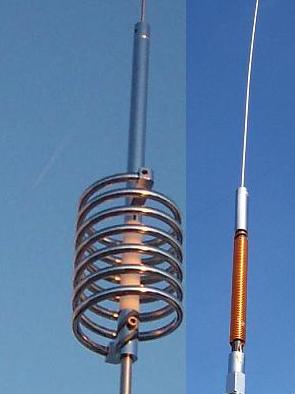
Eliminating those dielectric losses and increasing the conductor size does much more for the bandwidth and Q than it does for the radiated signal. As a side note, receive performance is most noticeably improved by making these changes. As it turns out, using large diameter tubing for the coil rather than flat stock actually helps improve the bandwidth because it slightly lowers the coil Q, but it does create a problem with coupling between turns in the coil, as Mr. Ward described earlier. Keeping the turns farther apart would solve this, but it adds length to the overall antenna.
For the most part, a shortened antenna that is 5 feet tall will perform just like any other shortened antenna that is 5 feet tall. Admittedly, subtle changes make very small differences. I admit that to some people, that extra tenth of a dB is desirable. For those with ‘export’ radios, and those that want to cover the entire 10m ham band with low SWR, the antenna Q is the most important factor. A fiberglass antenna with its narrow bandwidth is out of the question! A giant coil antenna is a much better choice. Not to mention those operators wanting to run higher transmitter power output levels. Large diameter antenna materials are a must to prevent overheating and antenna failure, which (when undetected right away) usually leads to amplifier failure too.
This is a good time to point out that these giant coil antennas usually weigh more, and have a lot more wind resistance than a fiberglass antenna. Don't try to mount a giant coil antenna on a typical brass stud mount, you will lose it! The heavy duty 3/8-24 stud mounts are a must. Mounts like the 'beehive' or 'gumdrop' types seem ideally suited for giant coil antennas.
It is easy to determine the bandwidth of one tune-able antenna compared to another without any expensive test equipment. Remember that 4-inch heavy duty spring I mentioned earlier? Now is the time to pull that out of the parts box and put it to work!
Do as I mentioned earlier- Tune the antenna without the spring for whatever frequency you want to use for your ‘middle band’ mark. Use a permanent marker to mark on the whip exactly at the point where it meets the ferrule it is inserted into.
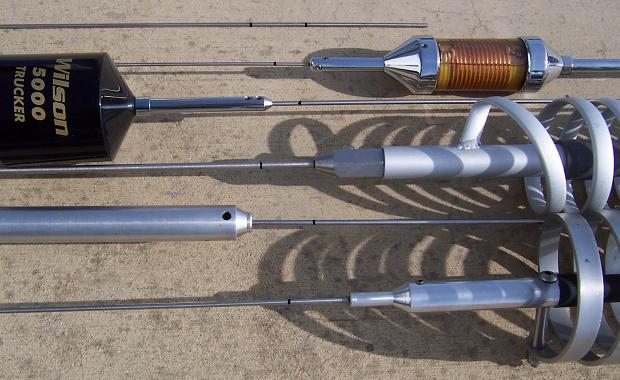
Unscrew the antenna from the mount and screw the spring to the antenna, then screw the spring down to the mount. Re-tune the antenna and make a mark on the whip where it meets the top of the ferrule. Repeat with your other antenna(s). Now, measure the distance between the marks. The antenna with the most distance between the marks has the lowest Q, and will have the broadest bandwidth. The antenna with the least distance between the marks will have the highest Q and the narrowest bandwidth. Simple!
So, after all of this, does a giant coil antenna work THAT much better than a similar length fiberglass whip or slim coil antenna? If your goal is only to get your 4-watt CB signal out, then the short answer is no. If your desire is to have an antenna that will handle large amounts of transmitter power and have a broad bandwidth, then the short answer is yes.
But it is important to point out here that when comparing a 5 foot tall fiberglass antenna like the Wilson FGT-5 and any of the high quality 5 foot tall big coil antennas, the actual gain on the horizon is exactly the same. There is a slight advantage in overall efficiency to the giant coil antenna, mostly due to reduced RF resistance in the overall antenna itself. There is a noticeable improvement in receive sensitivity over the fiberglass antenna, likely due to the larger flat plate equivalent area. Large pieces of metal make good receive antennas, that’s a fact. Ask any experienced shortwave listener.
...The Conclusion...
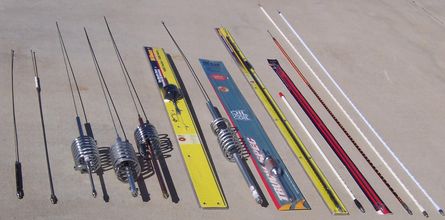
One thing this experiment did not take into account is called 'wow factor', or 'bling factor'. When driving around with a giant coil antenna on your vehicle, it does attract a LOT of looks from people around you. My wife’s favorite looking giant coil antenna is the Monkey Made MM9. She says it looks “manly” (her words, not mine). All other giant coil antennas get weird looks from her or negative comments.
The other thing is climates: One common ‘downside’ to using a giant coil antenna for those that mobile in cold climates, the giant coil antennas will ice up when below freezing, and in snow will fill up. That detunes the antenna, and will make for a high SWR until the antenna is cleared of ice and snow. This is one area where the small enclosed coil antennas and the fiberglass antennas have a major advantage.
A few honorable mentions now.
The winner of the most “bling factor” is hands-down, the Whiskey Still Jr. The polished copper shaft and chrome plated coil just flash. If your goal is to have a ‘show’ antenna, you just can't beat the glimmer and shine factor of a polished up Whiskey Still Jr.
Winner of strongest antenna goes to the Monkey Made. Since the antenna uses thick wall tubing and is completely welded, it would take an enormous collision to harm this antenna. My only reservation to the MM9 is that you cannot slide the whip in and out of the ferrule for tuning.
The K40 BCMAX nearly ties the Monkey Made in the strength category. It isn’t quite as strong as the Monkey Made (I doubt anything is), but it is similar with its welded construction. The questionable advantage it has is a tunable whip.
In fact, the whip can slide several inches into the antenna, so cutting becomes unnecessary. Good thing since the bottom of the whip is almost 1/4 inch diameter and takes bolt cutters to even dent it.
If you don't like the look of anodized aluminum, the K40 BCMAX takes paint very well. After cleaning everything very well with lacquer thinner, apply a few light coats of epoxy spray paint in your favorite color. The etched anodized aluminum makes a great surface for paint to grip. I recently painted one (gloss black) and it did not harm the performance at all.
Winner of both the lightest weight category and the field repairable category is the Whiskey Still Lite . The thing that made the antenna more fragile than the Monkey Made also makes it field repairable - it is built with good ol’ nuts, bolts, and screws. You can completely disassemble the Whiskey Still Lite in about 5 minutes, down to individual small parts. Any of those parts can be replaced by contacting Whiskey Still if they are broken or beyond straightening.
The extra light weight also means that a regular stud mount should handle the antenna just fine.
Easiest to tune category belongs to the Wilson FGT-5 fiberglass . I didn’t have to touch it at all from vehicle to vehicle. As it came out of the package, it was ready to go. No fussing! Install and go. It is, in my opinion, the ‘Antron 99’ of mobile antennas. If tuning is required for some reason, the tunable tip makes it quick and easy. Wilson even includes a rubber O-ring on the threads to help keep water out of your stud mount.
A word of caution- Once the rubberized plastic tip cover is in place, plan on it being there forever. It is nearly impossible to remove once in place.
Least expensive of all the 'giant coil' antennas is the Workman SP-3000 . Surprising since the construction and materials are really top-notch. Worth noting- I decreased end-to-end RF resistance by disassembling the SP-3000 and cleaning all metal-to-metal contact surfaces. Then, I applied Penetrox and reassembled the antenna.
The only downside to this antenna is that as it comes from the factory, the insulator is a white nylon type material that will probably not stand up to the sun and UV rays very long. It is an easy modification to fix that. Just disassemble the bottom half of the antenna and slide a piece of black heat-shrink tubing over the white plastic, slightly overlapping the metal above and below it. Heat the tubing with a heat gun to shrink it in place, being careful to not melt the insulator. Reassemble the antenna, and you have one kick-butt, long lasting 'giant coil' antenna for less than 35 bucks!
It was interesting that my old Half Breed base loaded antenna was able to hold its own against the giant coil antennas in almost every criteria, except for overall bandwidth. The top loaded Half Breed didn’t fare as well, and that was a little surprising. We have always been told that a center loaded antenna will work better than a base load, and a top loaded antenna better than a center load.
Seems that the position of the loading coil has less to do with overall efficiency than previously thought. The teeny-tiny wire wound over the teeny-tiny coil form in the top loaded antenna really hurt the overall efficiency. Over a perfect ground, the results could be different. However, on a semi truck or even a typical pickup truck, there is certainly no ‘perfect ground’ available, and therefore a center or top loaded antenna made with micro-diameter wire won’t work any better than a base loaded one.
In summary, antenna length is so much more important to how well an antenna transmits and receives than anything else. If you don’t have enough headroom for a 9-foot, full length quarter wave whip on your vehicle, you need to look for a good performing shortened antenna. Which shortened antenna you choose is up to you and your operating practices. If you decide on a 4 foot or 5 foot tall antenna, one works nearly like the other of the same length.
To expand, we proved that a 5-foot high giant coil antenna will NOT out-talk and will only slightly out-listen a 5-foot fiberglass antenna. There is NO large noticeable gain advantage to a giant coil antenna. However, if you want to run extra power, or want to cover a lot of frequency range with the same antenna, a giant coil antenna will satisfy your demands. Also, if you want an antenna that is stronger than the vehicle it is mounted upon, most of the giant coil antennas will stand up to monstrous abuse that would shake a fiberglass antenna to death.
For those CBers who don’t run an amplifier or ‘export radio’, and just want an antenna that won’t break the bank and doesn’t stand out in a crowd, then check out some of the popular fiberglass types. Rest assured, you aren’t really compromising how far you will transmit or receive.
...The Final Verdict..
In short, if anyone tries to convince you that a giant coil antenna has some big gain over longer antennas, then they are wrong. The 5-foot giant coil antennas cannot produce noticeable gain over another 5-foot tall antenna. And, most important, until the giant coil antenna length exceeds 9-feet, then it will never, ever have gain over the 9-foot whip. This experiment proves it.
Forummaster
CEF001
CVC001
|
    
Starface
Senior Member
Username: Starface
Post Number: 3011
Registered: 1-2005

| | Posted on Friday, April 08, 2011 - 2:48 am: | 


|
A very Good Read, Enjoyed the History and the Facts. |
    
Sitm
Intermediate Member
Username: Sitm
Post Number: 421
Registered: 1-2004

| | Posted on Friday, April 08, 2011 - 10:07 am: | 


|
I am so very glad to finally see this article posted. It dispells alot of myths out there that people repeat as fact. |
    
Tech237
Moderator
Username: Tech237
Post Number: 1423
Registered: 4-2004

| | Posted on Friday, April 08, 2011 - 11:11 am: | 


|
Hear hear. Don't know how many times I have tried to expain this with people who just would not accept any answer than the one they wanted to hear.
Tech237
N7AUS
God only made some many perfect head, on the rest he put hair.
|
    
Dale
Senior Member
Username: Dale
Post Number: 1699
Registered: 12-2002
| | Posted on Friday, April 08, 2011 - 3:17 pm: | 


|
very nice. i enjoyed this.thank you for
your time and work put into this.
dale/a.k.a.hotrod
cef426
cvc#64
|
    
Charliebrown
Intermediate Member
Username: Charliebrown
Post Number: 177
Registered: 10-2002
| | Posted on Saturday, April 09, 2011 - 8:12 am: | 


|
A true wonderful piece of work. Some of the best information to enjoy and to be very helpful when it is time to purchase an antenna. A TRUE MYTH BUSTER MASTER PIECE. COULD NOT HAVE BEEN DONE ANY BETTER TECH 833. |
    
Mikefromms
Senior Member
Username: Mikefromms
Post Number: 1105
Registered: 6-2003
| | Posted on Friday, April 15, 2011 - 11:56 am: | 


|
Wow, a lot of work involved here. Thanks so much. Seems to me that out of the bunch, the 5.5 foot k40 would be the best bargain and take up less space.
Mikefromms |
    
Tech833
Moderator
Username: Tech833
Post Number: 1959
Registered: 8-2002
| | Posted on Sunday, April 17, 2011 - 2:07 pm: | 


|
The Forummaster is preparing to publish the full article on HTML form, complete with all the pictures and omitted text. Will let you know as soon as he gives the OK to share.
Your radio 'Mythbuster' since 1998
|
    
Dale
Senior Member
Username: Dale
Post Number: 1700
Registered: 12-2002
| | Posted on Monday, April 18, 2011 - 6:22 pm: | 


|
another myth busted. seems like the big coil
antennas work the same or at least very close
to the same.
dale/a.k.a.hotrod
cef426
cvc#64
|
    
Tech833
Moderator
Username: Tech833
Post Number: 1961
Registered: 8-2002
| | Posted on Tuesday, April 19, 2011 - 11:50 pm: | 


|
Hi gang.
Thank you to the Copper Forummaster! The FULL article is now available online, complete with all photos and the full text!
http://www.copperelectronics.com/articles/big_coil_antennas_exposed.html
Your radio 'Mythbuster' since 1998
|
    
Marconi
Advanced Member
Username: Marconi
Post Number: 811
Registered: 11-2001

| | Posted on Saturday, April 23, 2011 - 11:13 am: | 


|
Forum Master, does this mean we can now link to this nice report from Tech 833?
Thanks for the hard work 833! |
    
Forummaster
Moderator
Username: Forummaster
Post Number: 551
Registered: 11-2001

| | Posted on Saturday, April 23, 2011 - 12:22 pm: | 


|
Marconi,
Yes please do.
Forummaster
CEF001
CVC001
|
    
Scrapiron63
Advanced Member
Username: Scrapiron63
Post Number: 877
Registered: 12-2001
| | Posted on Sunday, May 08, 2011 - 2:05 pm: | 


|
Paul this is a great review. I know it was a lot of work and it's much appreciated by this old radio dude.
It was also a trip down memory lane for me. I've been using CB radios for about 40 years and have owned or tried many many of the antennas you have in this article.
I've done lots of poorboy testing over the years but our unscientific methods didn't really prove very much. Thanks again.
Scrapiron
CEF 108 |
    
Tech833
Moderator
Username: Tech833
Post Number: 1991
Registered: 8-2002
| | Posted on Saturday, June 18, 2011 - 7:45 am: | 


|
A few fellow Copperites have emailed me about this, concerned as to why there are no pictures of the tests actually taking place, or video showing the procedure.
I really wish I could share the whole thing with you in video form, however, the range owner specifically requested that their facility not be identified in photos or video, nor named by name. The range is not mine, I rent it for professional work, and sometimes can sneak some hobby antennas on it. However, this isn't typical as they are very adamant about the range only being used for broadcast antenna testing.
If I were to divulge the location or details about the range and identify that it is being used for hobby purposes, it would be 'career suicide' on my part.
If you check out the online version, it does contain photos of all the antennas tested while mounted on the frame at the time they were tested. They are shot in such a way that no landmarks are visible, but clearly show the antenna under test when it was spun in the vertical position.
73,
833
Your radio 'Mythbuster' since 1998
|
    
Road_kill_radio
New member
Username: Road_kill_radio
Post Number: 6
Registered: 7-2011
| | Posted on Monday, May 28, 2012 - 4:52 pm: | 


|
...then there are the rare, 9' tall antennas which, correctly designed, by far outperform 9' SS whips. |
    
Scooterman
Junior Member
Username: Scooterman
Post Number: 29
Registered: 3-2012
| | Posted on Tuesday, May 29, 2012 - 10:26 am: | 


|
That is a nice scientifically written article. Well done. |
    
Tech833
Moderator
Username: Tech833
Post Number: 2170
Registered: 8-2002
| | Posted on Wednesday, May 30, 2012 - 2:18 am: | 


|
R.K.R., what antennas are you talking about? And, where is the test data published?
Your radio 'Mythbuster' since 1998
|
    
Unit199
Advanced Member
Username: Unit199
Post Number: 751
Registered: 8-2003

| | Posted on Thursday, May 31, 2012 - 5:48 pm: | 


|
Best article I have ever had the pleasure of reading on Antennas. Great info Tech833. Thanks a million!!!!
HARVE
UNIT199
CEF0210/CVC#018/HAM#010
Midwest 10 Meter Net Controller
|
    
Justin_383
New member
Username: Justin_383
Post Number: 4
Registered: 6-2012

| | Posted on Saturday, June 30, 2012 - 11:49 am: | 


|
Nice article it was a good read and it help alot seeing as I was thinking about getting a coil antenna.
27.1650 shout for 383
|
    
Milkman21218
Advanced Member
Username: Milkman21218
Post Number: 500
Registered: 1-2004
| | Posted on Saturday, June 30, 2012 - 11:27 pm: | 


|
Great work as always 833! I've run the Workman SP-3000 5.5ft ant for a few years on a Big Truck slip seating. And I got very, very good results. I could easly do 10-20 miles with my Grant XL on AM. And everywhere on SSB. It was the best mirror mounted antenna I've ever had. I still own it just don't drive Big Truck anymore. Back in the late 90's Copper sold them for $17.99. And it was the best money ever spent.
Izzy
CEF#502
|
|



